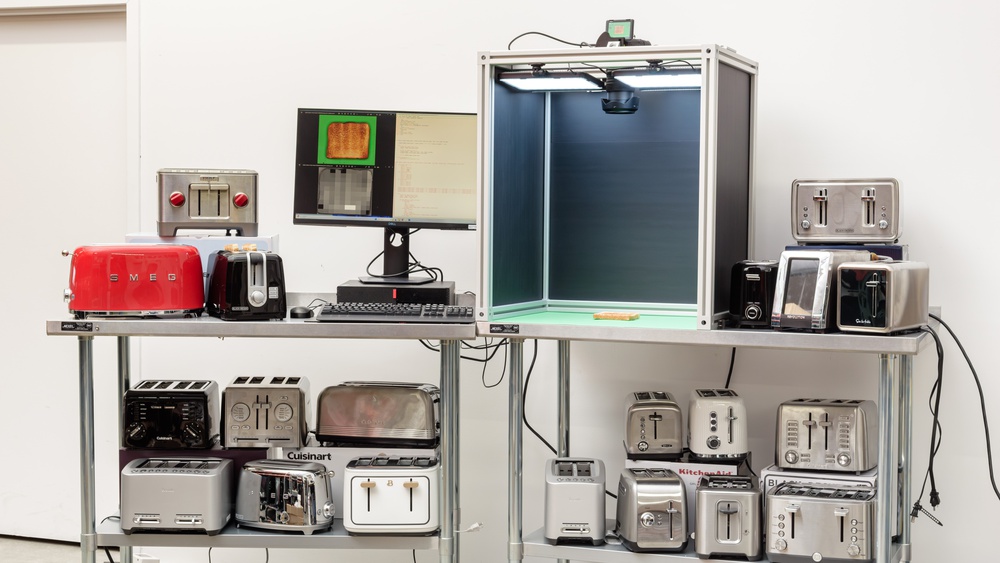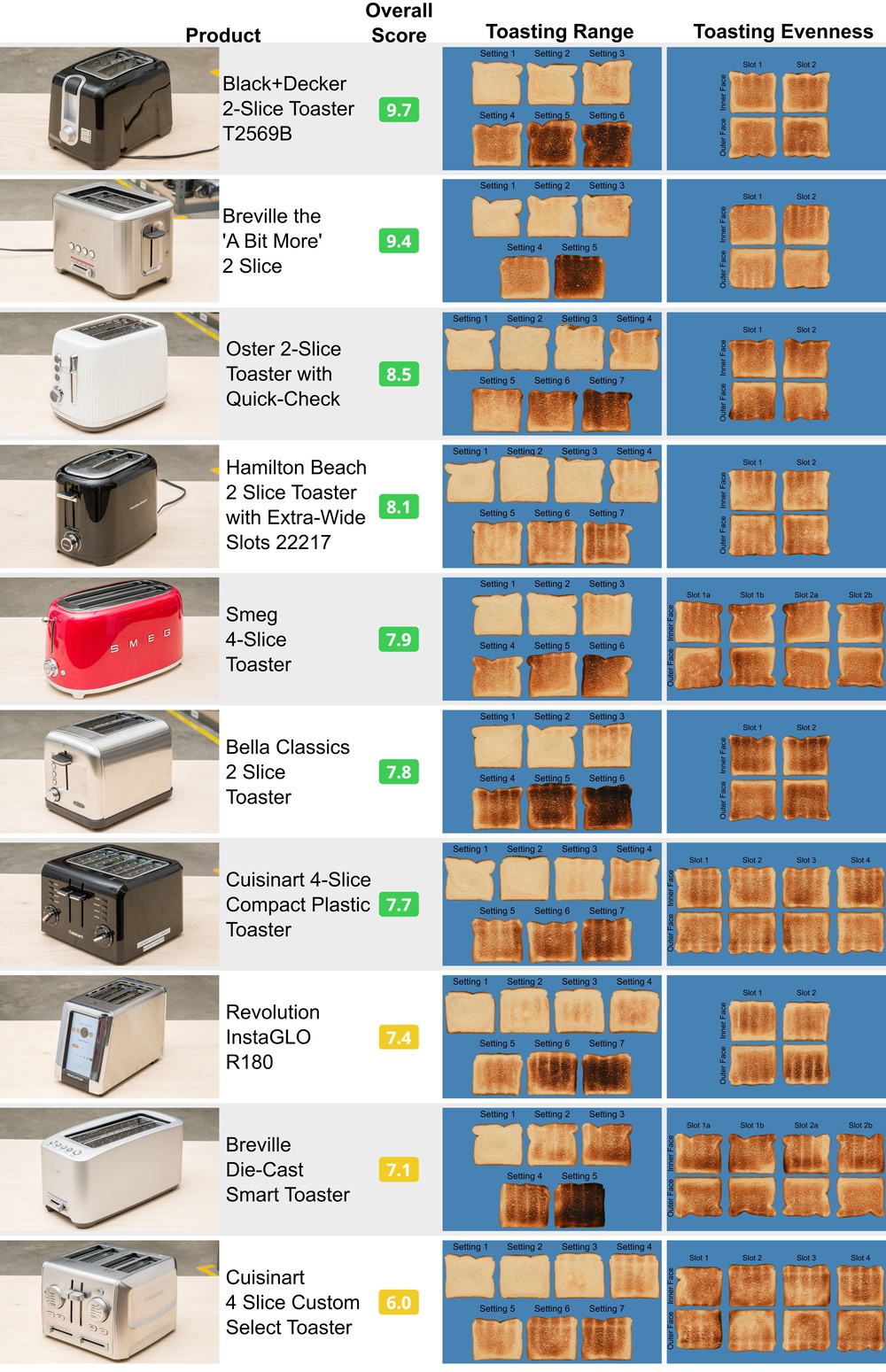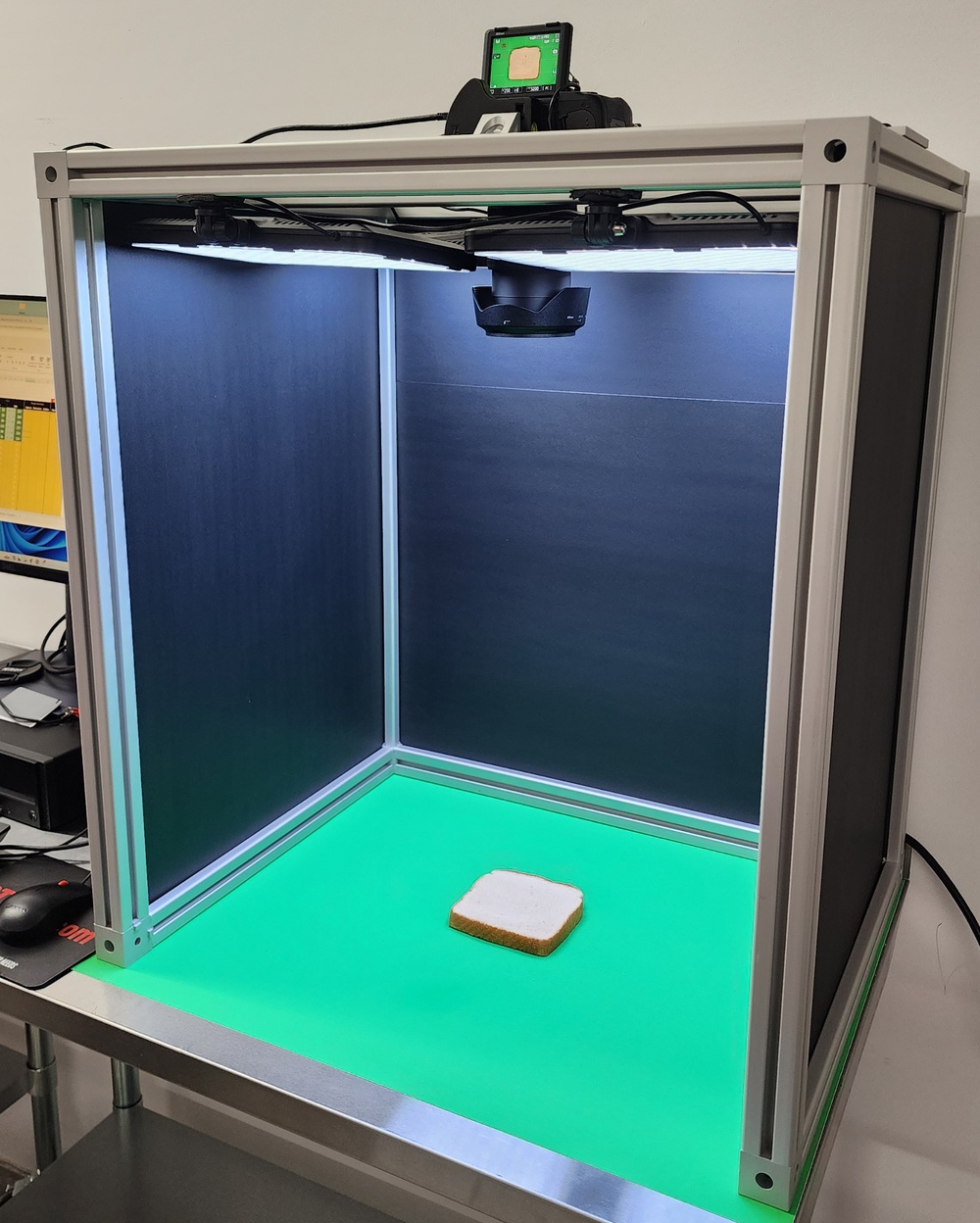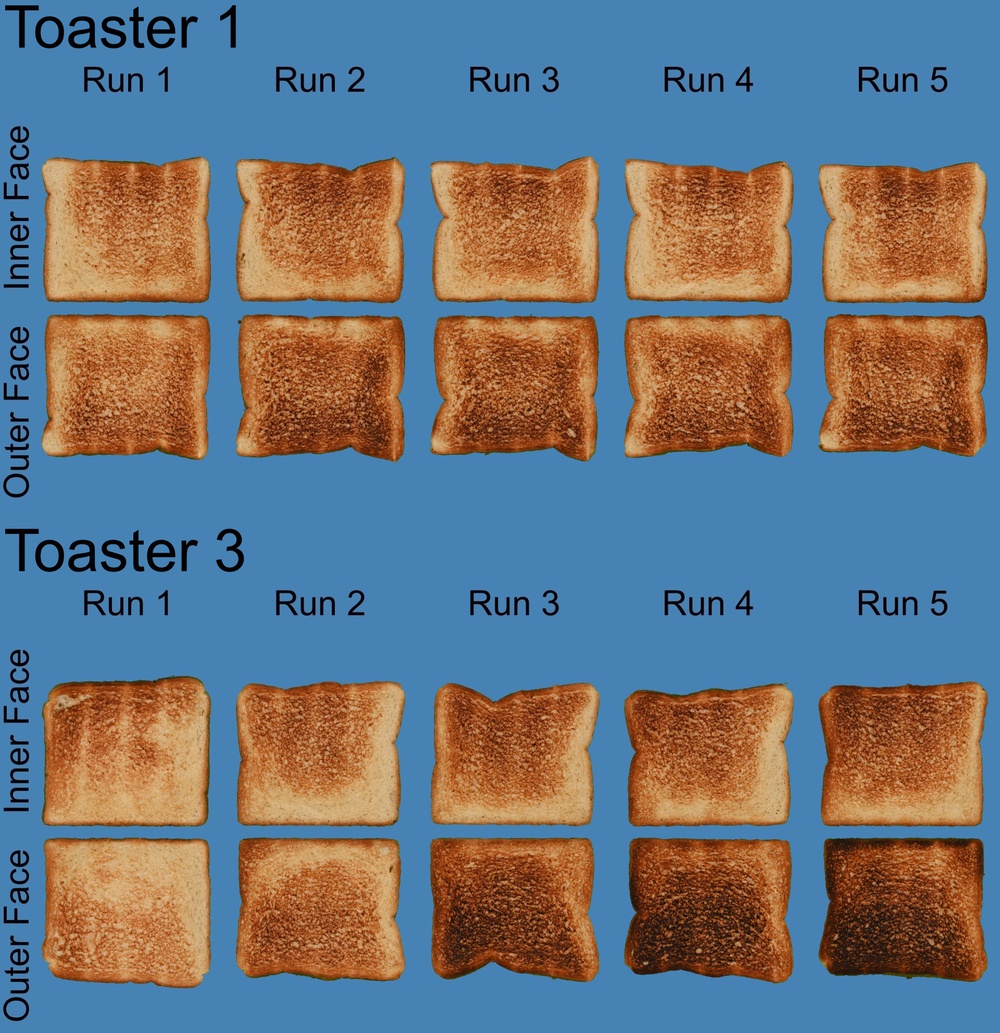20 Toasters Tested, 650 Slices of Toast Analyzed
The Pricier Appliance Isn't Better
The slot toaster is an indispensable kitchen appliance. In almost every region of the world, toasted bread is the perfect base to add delicious local sweet or savory toppings. But which toaster will serve you best and repeatably produce bread at just that right shade? We here at RTINGS set out to devise an objective set of tests to give users organized, comparable data to answer that question and to choose the perfect slot toaster for their needs.
We're especially excited about the "performance" section of the test bench. Here, we've developed three objective tests based on image analysis techniques to explain an appliance's toasting range, toasting evenness, and repeated toasting ability. We invite you to explore the full results of the toaster test and compare results (including result photos) using the Toaster Table Tool! You will also find our picks for the best 2-slice toasters and the best 4-slice toasters on our website. In developing these tests, we realized how much electrical power some of the larger 4-slice toasters draw and how the circuitry in one's home (and even in our lab) can greatly affect the toasting results!
In the end, we tested 20 of the most searched-for toasters; you can see a small portion of the results in the next figure, and all of the results of the tests are here. Looking at the results as a batch reveals something interesting and counterintuitive: the more expensive slot toasters don't perform better than the least expensive options in our cohort. Disassembling some of the models exposes a strikingly similar interior to the appliances. While higher-end toasters offer touchscreen controls, motorized bread carriages, and robust metal casings, the slots still consist of parallel sets of resistive wire heating elements on insulating mica sheets, and timers control these heating elements in an on/off fashion. In the end, the performance of a slot toaster appears to come down to how centered the baked good is within the slots (and some toasters did fail at this basic duty!) as well as how much heat from the elements is transferred to the surrounding environment rather than to the baked good in the slots. We found that the inexpensive Black+Decker 2-Slice T2569B toaster effectively centers bread in its slots and evenly transfers a suitable amount of heat to the bread, making it our highest-rated toaster.
In this article, you can read more about how we designed our tests, how household electrical circuitry may affect the performance of larger toasters, and our investigations into the surprising performance of some of the 20 appliances we tested.
Objectively Testing Toaster Performance
Consistent photography is the first key to objectivity
We opted to carry out all the "Performance" tests using commercial white sandwich bread (e.g., Wonder Bread). Room-temperature white sandwich bread offers a blank canvas on which imperfections in heating/toasting are difficult to hide. Furthermore, factory-baked bread has good loaf-to-loaf consistency with regard to texture and color, giving us a well-controlled variable for our tests.
We went to work on designing a setup for the consistent capture of photographs of the toasted white sandwich bread. After a few iterations, we arrived at what you see in the photo at right. With this apparatus, we evenly light the toast and do so consistently regardless of changes in ambient lighting in the lab. The camera is also rigidly mounted overhead so that we photograph all pieces of toast from the same angle and distance.
Our newfound ability to capture consistent photographs of toast allows us to visually differentiate the performance of these appliances. As shown in the next figure, when we capture photos of toast prepared over the range of browning settings of each appliance, we can elucidate performance differences regarding both "toasting range" and "toasting evenness." For the toasting range, there's a noticeable difference in the maximum darkness that these two toasters can produce on white sandwich bread, with toaster 2 producing much darker toast at its highest setting. The ability to char toast may be important to specific users who like their breakfast that way. However, it also indicates that the appliance has a sufficiently long automatic toasting cycle to handle frozen baked goods and denser breads. For toasting evenness, Toaster 2 appears to be more consistent in how it toasts each face of each slice of bread; at the "Golden Brown" setting, we achieve a remarkably consistent browning pattern regardless of the slot used and regardless of the toast face. Contrarily, for Toaster 1, the toast made in slot 2 is darker than that made in slot 1, and the outside face of that toast is especially dark.
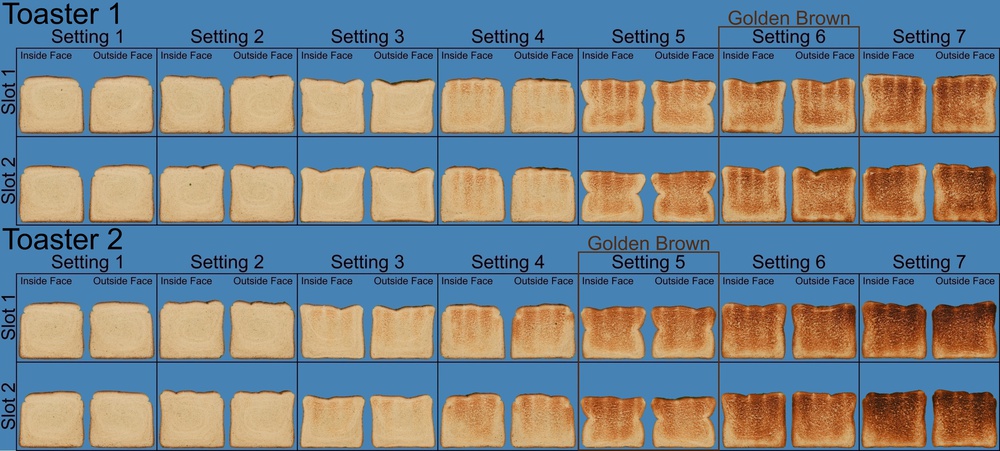
Photographing toasted white bread from two different appliances. Toaster 2 yields darker toast than Toaster 1 at the maximum setting. Toaster 2 produces more even toast at the “golden brown” setting.
Consistent photography also naturally allows us to differentiate the performance of toasters regarding the preparation of several large batches of toast. The figure to the left presents photographs of toast made using the golden brown setting of two different models over five immediate successive runs of the toasters. Toaster 1 yields consistent toast; while the outer face is dependably darker than the inner face, the results are the same from run to run. We can't say the same for Toaster 3. The outer face of toast prepared in this appliance gets darker with successive runs, likely due to the heating up of the appliance. The result is toast that's charred on one side after only a few cycles of the appliance.
In sum, a rigidly mounted camera with well-controlled lighting allows us to take consistent photographs of toast and elucidate differences in toaster performance.
Image processing is the second key to objectivity
While the well-controlled photography of toast allows us to elucidate important differences in the performance of toasters, two issues arise:
- We very quickly amass a large number of photographs when testing each toaster, and we would have to manipulate each of these in some way (e.g., renamed, resized, superimposed onto a master figure, etc.).
- While the photographs give people shopping for a new toaster a great visual representation of performance, they lack a synthesized, numerical description to compare the entire cohort of tested appliances (i.e., it's difficult to assign a score to photographs).
We solved both issues with a custom computer code that handles the collection and analysis of toast photographs. A general, high-level overview of how the Python code automatically creates montages of the toast prepared by each appliance is presented in the next figure. The code controls the camera—collecting each raw image of toast on the photo cube's green background—and appropriately renames and organizes the files. After roughly cropping each photograph, we use a masking technique to separate each piece of toast from its background. Here, the Python code disregards any loose crumbs that may have been in the photograph and detects the bottom edge of the toast to straighten the object so that all the final images are aligned. Finally, montages of these images are automatically built so that you can make visual comparisons for range, evenness, and repeatability.
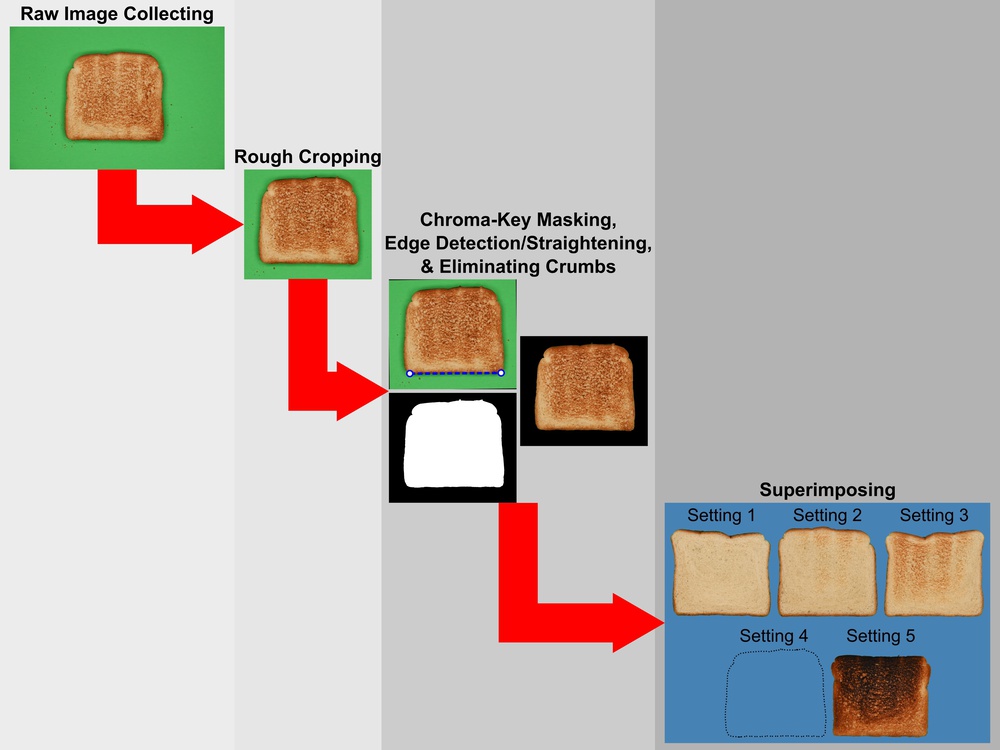
General overview of the automated process for the collection of photographs and extraction of toast images for creating montages.
To move beyond a visual comparison and towards an objective numerical evaluation of the toaster's performance, the Python code facilitates a series of image analyses, as outlined in the next figure. In all cases, we convert the toast photographs to grayscale, and the toast crust is separated out, leaving behind the "toast crumb." We use these grayscale crumb images when performing the analyses and calculations that make up the "Toasting Range," "Toasting Evenness," and "Repeated Toasting" boxes of each review.
We developed our tests for the "Toasting Range" box by building upon the methodology of the Association of Home Appliance Manufacturers for household electric toasters. The AHAM T-1-2016 standard visually compares toast prepared using each appliance's browning settings against benchmark photographs. Each browning setting of a toaster should produce different results, from pale to charred. As shown in the next figure, we have made this process considerably more objective by comparing the pixel value histograms of the grayscale toast crumb images to a standard we constructed rather than relying on visual evaluations.
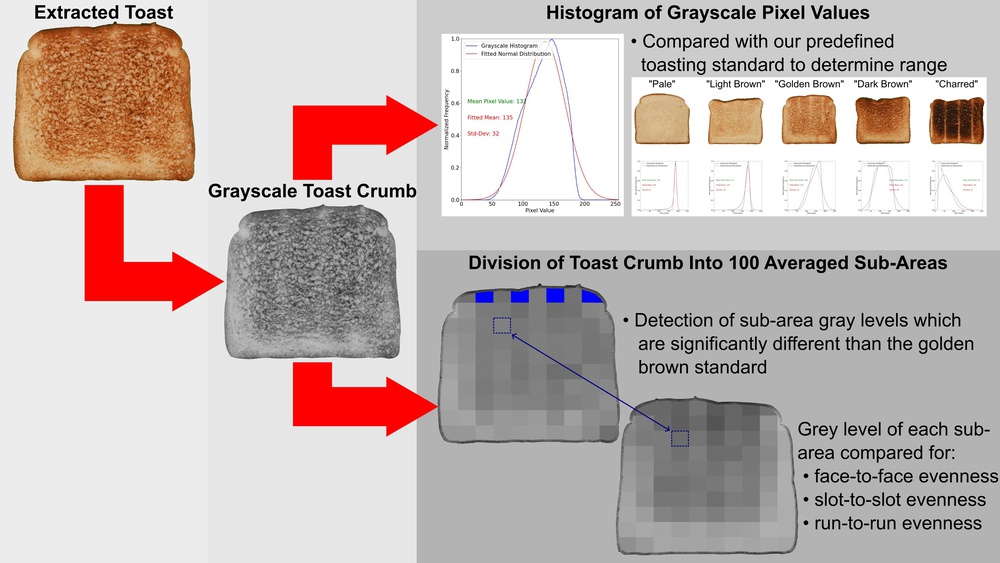
General overview of the automated process for the extraction of numerical results from the collected toast photographs.
In the end, automated imaging processing allows us to efficiently organize the huge number of toast photographs taken during testing and quantitatively elucidate the performance of the toasters.
The Electrical Circuit of Your House Can Influence Toasting Performance
Our original plan was to perform all the toasting in a dedicated space in the far corner of the RTINGS lab. However, early in developing our toaster test bench, we noticed that large 4-slice toasters didn't yield the expected results. While the 2-slice appliances routinely produced charred (even burnt) toast at their highest settings, the 4-slice appliances struggled to create dark-brown toast. Typical results are presented in the following figure. The top row is the toast made in the Breville Die-Cast 4-Slice Smart Toaster at the original testing location, approximately 250 feet from the lab's main electrical panel. Using a plug load logger to measure the voltage while running the appliance revealed the problem; even though this is a dedicated 20A circuit, the sheer distance from the electrical service panel results in a significant voltage drop over the conductors (107 V when one would expect ~120 V) and ultimately a significant decrease in the power delivered to the appliance (~1400 W when Breville advertises 1800 W).
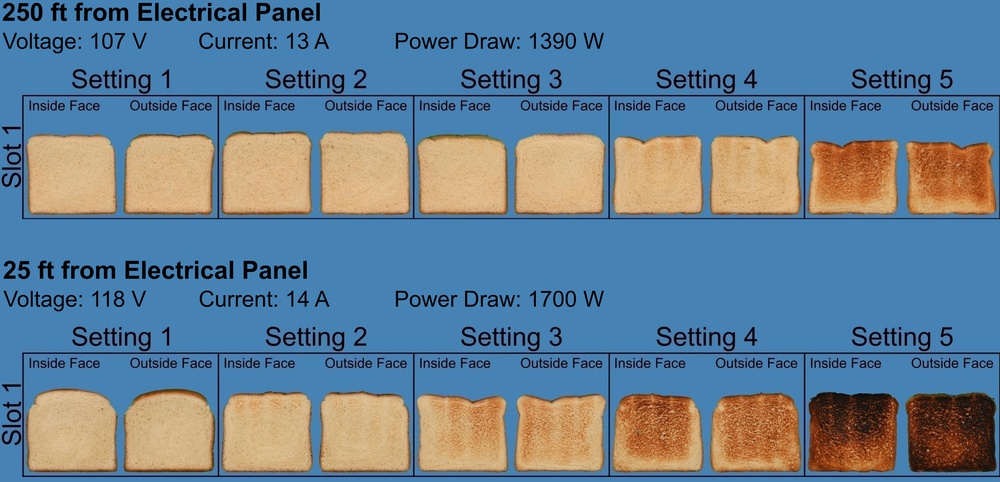
Photographs of toast made in the Breville Die-Cast 4-Slice toaster using outlets at varying distances from the electrical panel. The effect of voltage drop is stark on appliances which draw large amounts of power.
Voltage drop is a well-understood phenomenon. It's caused by the resistance of the conducting wires themselves and becomes significant with especially long wires and high currents. To calculate voltage drop, one needs to simply apply Ohm's law to the total length of wire:
Here, we've measured the current through the wire, I_wire, as 13 A. The resistance of standard gauge copper wires is tabulated in Ohms/1000 ft. Thus, for our total circuit (to and from the lab's electrical panel):
A final voltage after this drop of 120 V - 11 V = 109 V matches the 107 V we measured with the plug logger well.
We changed course in our planning for the toaster tests and moved the setup to a location as close as possible to the lab's electrical service panel while still having sufficient space and ventilation. You can see the results of this move in the lower half of the figure above. Here, the same Breville 4-slice toaster performs remarkably better and can char the bread at its highest setting, as voltage drop this close to the panel isn't a problem, and the appliance can draw 1700 W of power.
Power draw, current, and voltage drop aren't likely aspects that users think about when adding an appliance to their home—especially a small appliance like a toaster. But they're consequential in terms of performance and safety! Many of the 4-slice toasters we tested draw over 1500 W and wouldn't be able to be run on the same 15 A circuit at the same time as, say, a coffee maker. It's perhaps counter-intuitive, but all the toasters we tested draw more power than the best-selling stand mixer and more power than some major appliances like refrigerators.
To summarize, keep the total current draw (and the distance from the electrical panel) in mind as you shop for a toaster!
Choosing "The Best" Toaster Isn't As Simple As Choosing A High-End Brand
A toaster's price doesn't correlate with overall performance
Testing the 20 appliances in a cohort like this allows us to deduce interesting information on the toaster product category. Perhaps the most interesting observation we make on the dataset we've amassed is the apparent lack of connection between price and toasting performance. The next figure presents a plot of the overall "Toasting" usage score (the score you'll see at the very top of every review) versus the sale price of the appliance at the time of writing. Our cohort of appliances covers a rather wide range of prices, from $29 (for the Black+Decker 2-Slice Toaster T2569B) at the low end up to $399 (for the Wolf Gourmet 4-Slice Toaster) at the high end. The test bench we've developed doesn't consider "quality of life" features in the scoring, which may be worth the extra price for some shoppers. For example, while we tabulate the presence of features like bagel and frozen buttons, we don't test for their utility. Similarly, we present the material/finish of the toaster body but don't assign scores.
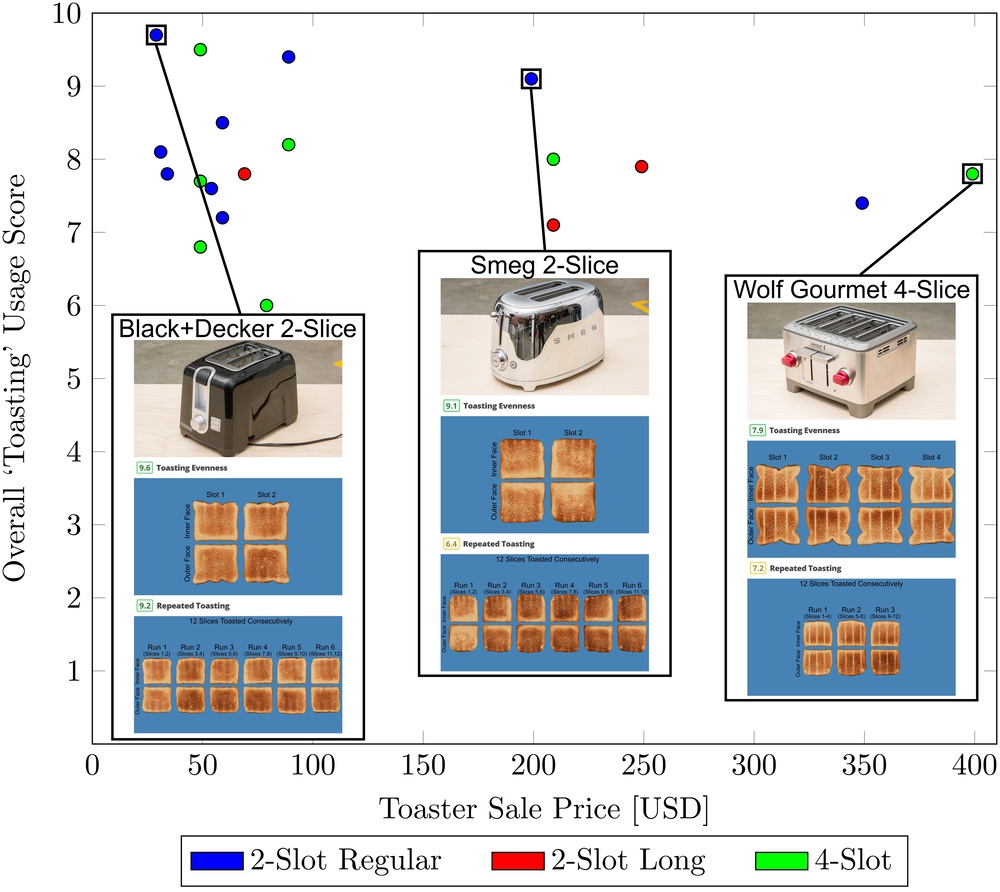
The plot of the toasters’ overall usage scores versus sale price shows no positive correlation. The three overlays show the toast produced in a budget, mid-range, and high-end appliance.
The high-end $399 toaster indeed comes in a nicer finish, has a premium stainless-steel body and the classic Wolf red knobs, and the toast lowering levers have a very satisfying sturdy feel (and the bread clamps themselves are unique in that they're always parallel). Nonetheless, as shown in the overlay on the plot in the preceding figure, the toast produced is middling; toast made in the inner slots is darker than those made in the outer slots, and after the first run of the appliance, your toast will be noticeably darker. On the other hand, the $29 Black+Decker 2-slice toaster has as basic a body as you can get. It's black plastic all around, and the toast lever is so ordinary that you will never mention it to anyone. However, this appliance produces exceptional toast, which is very evenly browned and will do so consistently from batch to batch.
Read on to see part of our investigations into why some toasters perform better than others and perhaps why price isn't a good performance indicator.
The bread clamps
Do The Wolf Gourmet's Bread Clamps Add Value?
First, we had to know if those fancy parallel bread clamps on the Wolf Gourmet functioned better in some scenarios than the pivoting clamps every other toaster uses. In the following videos, you'll see the difference between the two clamping styles and how each clamps a baked good. We placed an English muffin in the slots of the Wolf Gourmet 4-Slice and the KitchenAid 2-Slice toasters to see if the parallel clamps were better at centering small food items. We purposely started with the English muffin halves as skewed in the slot as possible. And with both toasters, the English muffins end up centered and vertical in the respective slots. But the Wolf levers do feel great!
The Revolution Instaglo R180 We Purchased Had a Faulty Bread Clamping Mechanism
The high-end Revolution InstaGLO R180 boasts a touch-screen interface and specially developed heating elements, which Revolution claims heats up extremely fast and creates exceptional toast. However, as you can see in the following video, the outer clamps of the unit we purchased don't move nearly as much as the inner clamps do. The result is bread that sits much closer to one set of elements (the outer elements).
The toast that results from the uneven clamping is shown in the left-hand images of the next figure. Our testing revealed that toast made in the InstaGLO R180 has an outer face that's much darker than its inner face. Centering the bread by nudging the clamps with a wooden ruler corrects this problem, as demonstrated by the right-hand images in the figure. We suspect that the fault in the bread clamping mechanism of our unit simply lies with a cheap, poor-quality spring that applies insufficient force to the outer set of clamps. This is an especially frustrating engineering design choice, considering that this toaster is one of the most expensive in our cohort at $349 at the time of writing.
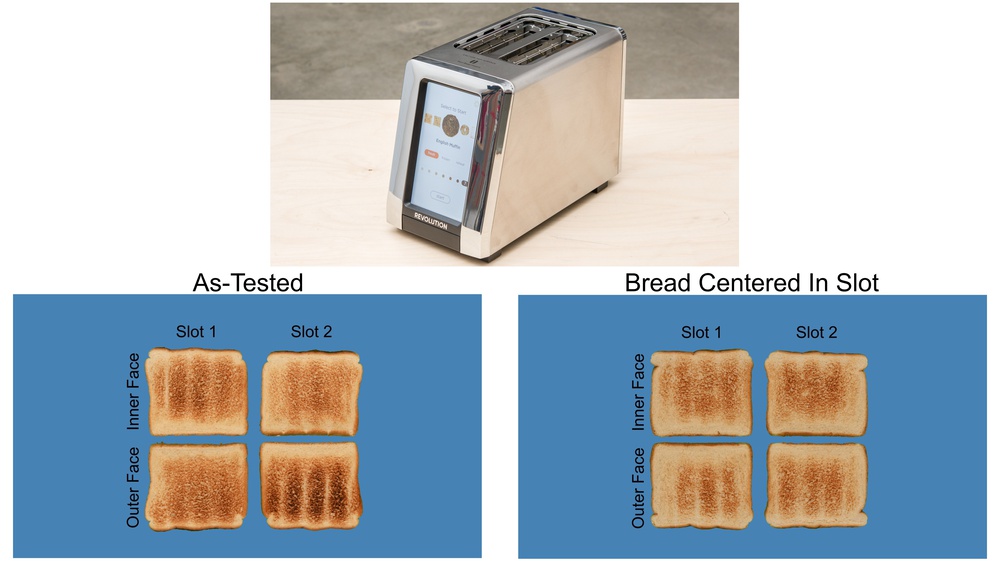
Photographs of toast prepared in the Revolution InstaGLO R180. The outer clamps of our unit have less force than the inner clamps meaning bread sits closer to the outer elements and the outer face gets darker. Manually centering the bread in the slot fixes this issue.
Even toasting is all about heat transfer
We were curious to find out what about a toaster's design results in an unevenly browned slice of toast. Two appliances we tested—the Black+Decker 2-Slice Toaster T2569B and the KitchenAid 2-Slice Toaster with manual lift lever—are perfect for comparing design choices and their consequences. While the Black+Decker and KitchenAid have very similar power draws (855 W and 865 W, respectively) and very similar slot dimensions (5.4" x 1.5" x 5.0" and 5.6" x 1.5" x 5.1", respectively), they have vastly different "Toasting Evenness" performance. As shown in the following figure, the Black+Decker is our highest-scoring toaster at 9.6, and the KitchenAid receives our lowest Evenness score at 5.5. Here, we can see that the unevenness of the toast made in the KitchenAid is due to the inner faces being browned much more than the outer faces.
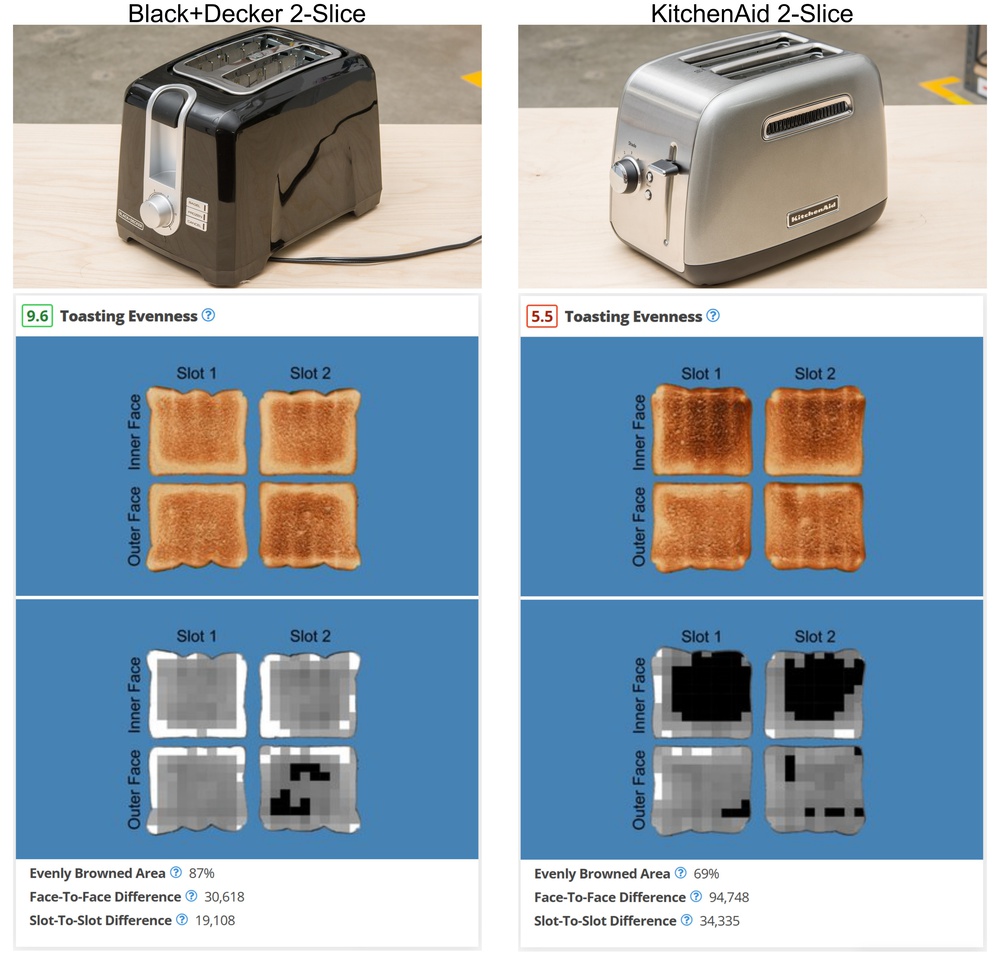
The Black+Decker and KitchenAid 2-Slice toasters we tested have very comparable dimensions and power draws but vastly different toasting evenness performance.
We first confirmed that bread is held in the slots of both toasters in a consistent manner. That is, the difference in toasting evenness between these appliances isn't simply due to bread sitting closer to one of the elements during the toasting cycle, as in the Revolution InstaGLO R180. Next, we wondered if the KitchenAid's inner (middle) element(s) produced more heat than those of the Black+Decker, causing the inner faces of the bread to become more toasted. The following figure shows that a slot toaster is an extremely simple appliance. When the lever of the toaster is lowered, it closes a switch and allows current to flow through sets of high resistance wires, which are mounted on insulating mica sheets. The lever is held in place by an electromagnet which releases after a timer goes off (the shade setting knob adjusts this timer). As long as the current flows through the toaster, the wires making up the elements emit heat, toasting your bread.
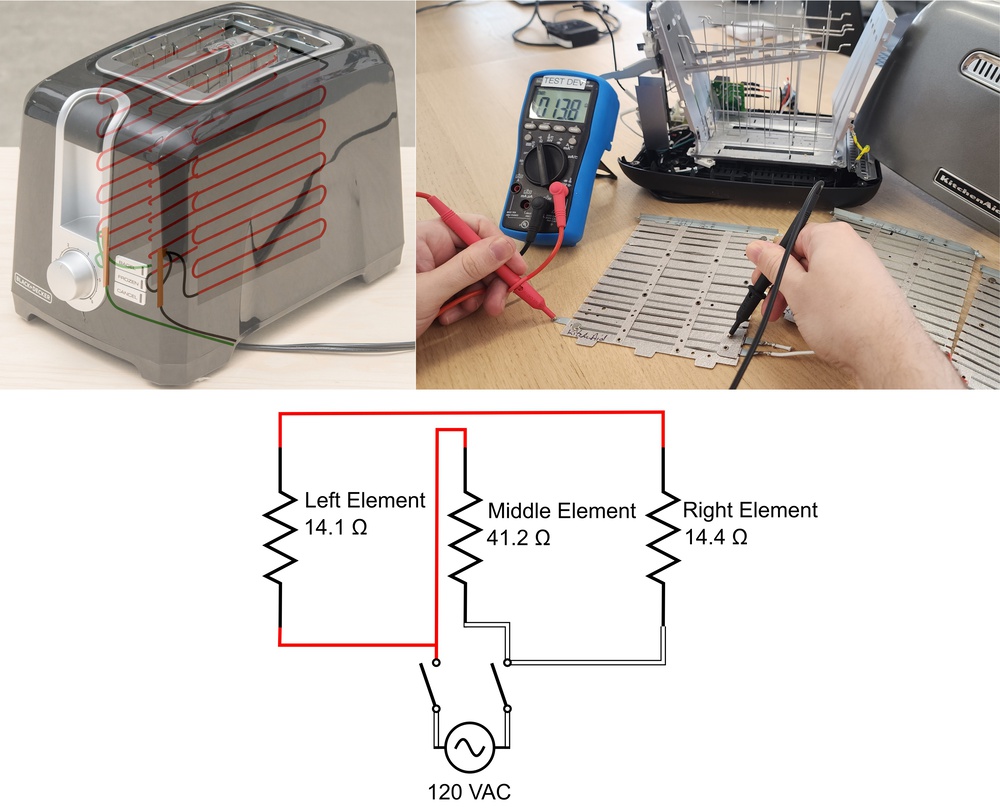
The heating elements of a slot toaster are a set of resistors. The two outer elements (left and right elements) are wired in series and are, in turn, wired in parallel with the middle element.
A teardown of the Black+Decker and KitchenAid toasters revealed that both appliances are simple on/off devices; if the lever is down in normal mode, all elements are powered. (Note that the KitchenAid's bagel button turns off the outer elements while the Black+Decker's does nothing more than add time to the cycle). The Black+Decker is so simple that there's no digital timer in the circuit; the shade control knob is connected to a potentiometer which thus determines the rate that a capacitor is discharged. Once the capacitor is fully discharged, the electromagnet holding the toast lever releases, the main switch is opened, and the toast pops up. The "Frozen” and “Bagel" buttons on the front panel of this toaster simply add another capacitor into this circuit, thus adding time to the cycles.
In sum, our teardown of the two toasters showed no controlled regulation of current flow through each of their respective sets of elements. These are simple circuits of resistive heaters. In both cases, the outer elements of the toasters (labeled left and right elements in the circuit diagram of the above figure) are wired in series and are, in turn, wired in parallel with the middle element (which is a single wire wrapped around a mica sheet that heats both slots). This means we can determine the power distribution through the heating elements by measuring their individual electrical resistance and performing simple calculations using Ohm's and Kirchoff's Laws.
Measurements and calculations performed on the Black+Decker and the KitchenAid toasters reveal that the resistances of their elements are very similar. Thus, both toasters have an equivalent heating power distribution throughout their slots. This is summarized in the following table:
| Black+Decker | KitchenAid | |
|---|---|---|
| Left Element Resistance13.6 Ω | 13.6 Ω | 13.9 Ω |
| Left Element Power | 249 W (29%) | 254 W (30%) |
| Middle Element Resistance | 40.2 Ω | 39 Ω |
| Middle Element Power | 346 W (41%) | 357 W (41%) |
| Right Element Resistance | 14 Ω | 13.7 Ω |
| Right Element Power | 256 W (30%) | 250 W (29%) |
To summarize, we now know that the differences in "Toasting Evenness" performance between these two appliances aren't due to the bread being held differently in relation to the elements, nor is it the result of different distribution of power/different amounts of heat from each element. There's only one explanation left for the differing performance. These two toasters must transfer heat differently to the surrounding environment such that the temperature at the middle plane of the KitchenAid is higher than that of the Black+Decker. i.e., the difference is not due to heat in but rather heat out!
We tested our heat transfer hypothesis by taking infrared (IR) images of each toaster at 1-minute intervals while running the golden-brown setting. These IR images are compiled in the figure that follows. Note that some areas of the KitchenAid's body are reflective, making IR thermography unreliable; as such, we also measured temperature using a surface-mounted thermocouple. The thermocouple readings are presented as the overlaid temperatures in the figure. The surfaces of both appliances get warm by the end of their toasting cycles, but the KitchenAid's body gets more evenly warm. This is especially evident when one compares both toasters' left and right sides. The middle of the left and right sides of the KitchenAid reach 33 °C and 36 °C, respectively, by the end of the toasting cycle, while the middle of the left and right sides of the Black+Decker only reach 30 °C and 29 °C, respectively.
Moreover, the IR images reveal that the sides of the Black+Decker body are less evenly heated, leaving much of the surface even cooler. A temperature gradient will form if heat is transferred out of the toaster at a sufficiently high rate. The IR measurements suggest that is what is occurring in the KitchenAid, with its mid-plane being the hottest. This temperature gradient results in uneven toast, with the inner faces much darker than the outer faces.
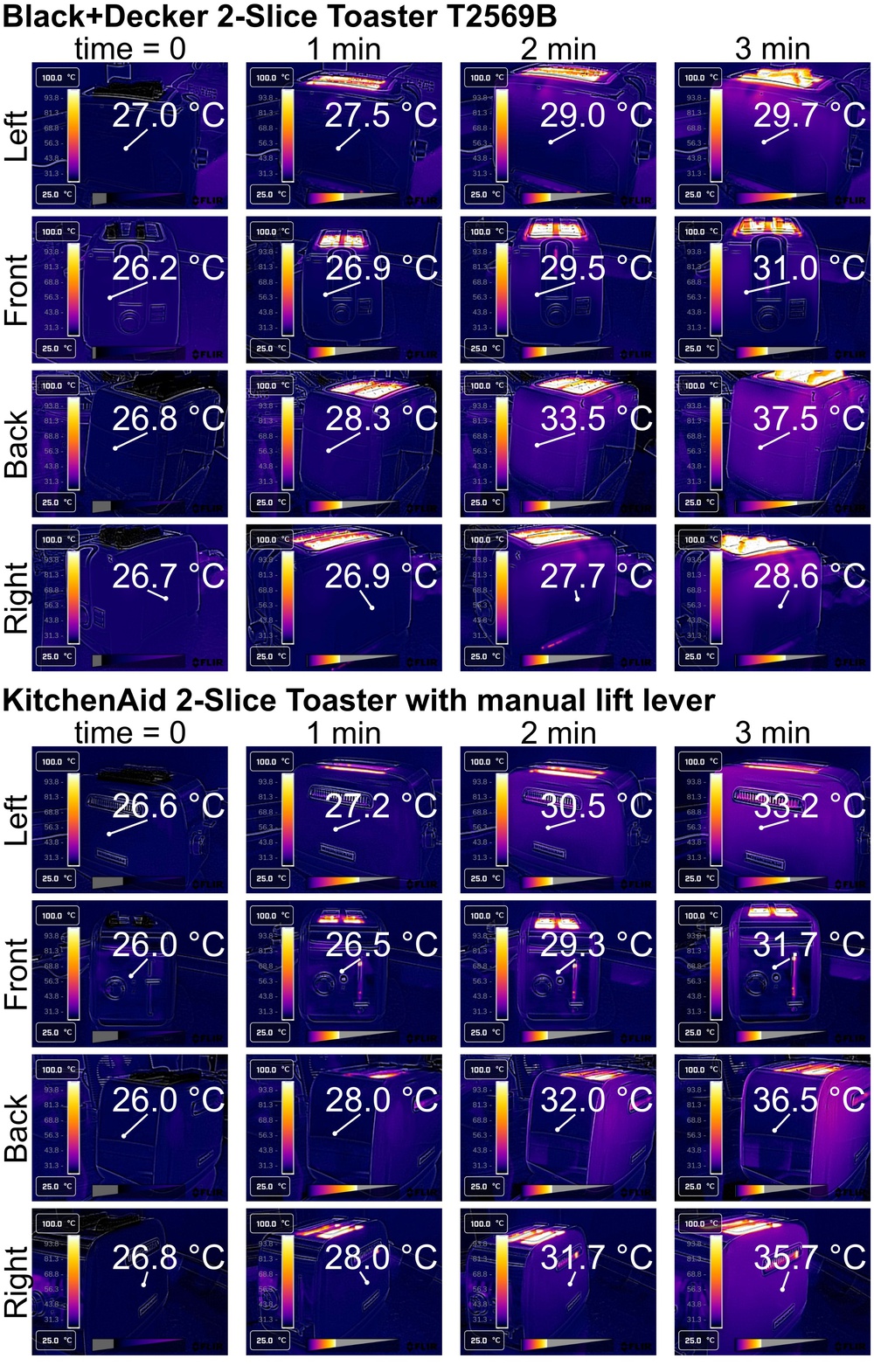
Infrared camera images of the Black+Decker and KitchenAid toasters taken while running their golden-brown toasting cycles. Heat is transferred more readily from the body of the KitchenAid, especially at the sides of the toaster, compared to the Black+Decker.
Our experience with these otherwise similar toasters suggests that performance is greatly affected by the body construction of the appliance. In the case of the Black+Decker compared to the KitchenAid, the difference appears to come down to the material of the body. The all-over plastic body of the Black+Decker is rather insulating such that the appliance's interior gets evenly warm. On the other hand, the two metals of the KitchenAid body are conducting, with the side panels getting especially warm and transferring heat from the interior readily.
You may have to choose between a hot appliance or repeatable results if you plan on making large quantities of toast
Beyond the apparent differences in "Toasting Evenness" performance, we also observed considerable differences in the ability of our tested appliances to prepare large batches of toast repeatably. This test involved preparing a total of 12 slices of toast, which, for the 4-slice models, required three runs of the toaster back-to-back. Two of the appliances we tested—the Beautiful 4-Slice Toaster with Touch-Activated Display and the Breville Die-Cast 4-Slice Smart Toaster—are ideal for comparing design choices and their consequences. While the Beautiful and Breville have very similar power draws (1720 W and 1700 W, respectively) and very similar slot dimensions (5.4" x 1.4" x 5.1" and 5.5" x 1.4" x 5.2", respectively), they have vastly different "Repeated Toasting" performance. As shown in the following figure, the Beautiful is one of our highest-scoring toasters at 8.4, and the Breville receives one of our lowest Repeated Toasting scores at 5.1. Here, we can see that the low repeatability of the Breville is due to the inner face becoming much darker than the outer face after just the first run, and the problem is especially apparent with the toast made in run 3. This darkening phenomenon is occurring to a much lesser degree in the Beautiful toaster.
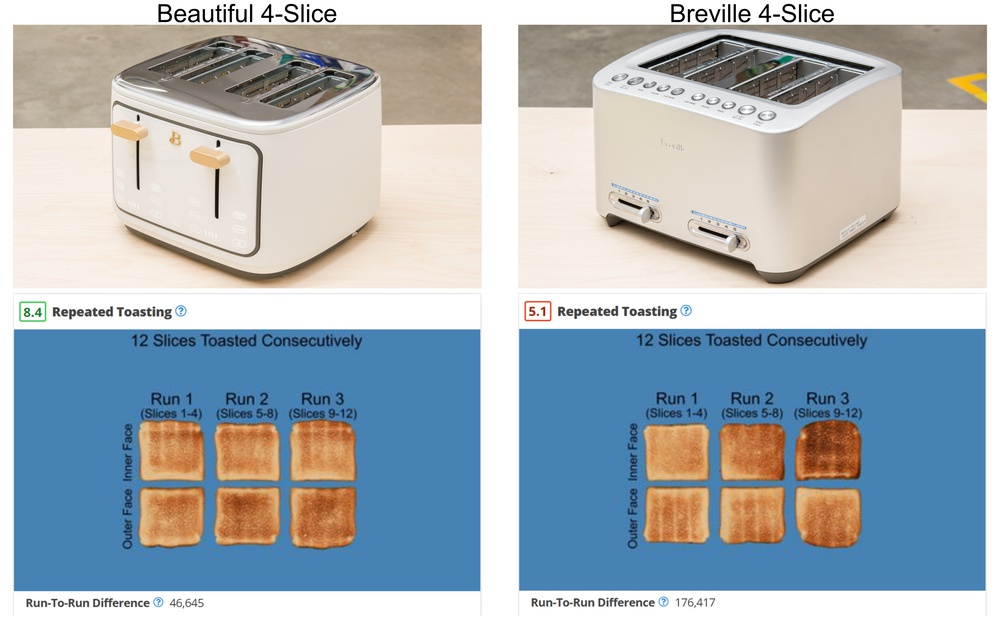
The Beautiful and Breville 4-Slice toasters we tested have very comparable dimensions and power draws and have vastly different repeated toasting performance.
The change in degree of toasting with time indicates an accumulation of heat within the Breville toaster. As we did with the investigation into differences in "Toasting Evenness," we looked into how heat transfers from each toaster to the surroundings by capturing infrared images of their respective bodies at 1-minute intervals. You can see these images in the following figure, which were taken over the three runs of the "Repeated Toasting" tests.
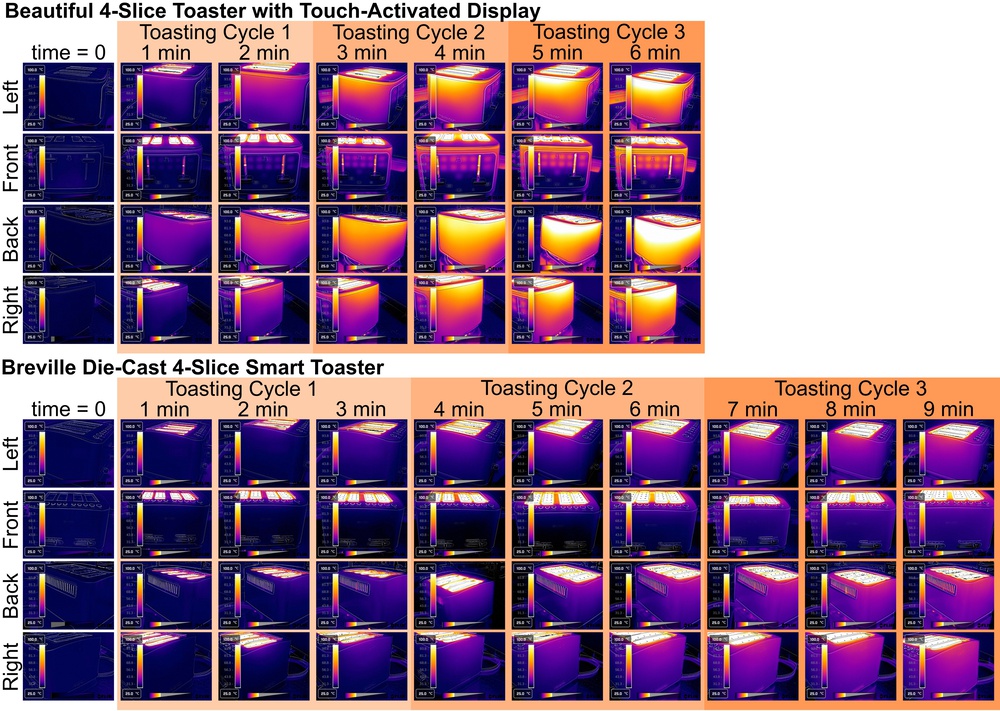
Infrared camera images of the Beautiful and Breville 4-slice toasters were taken while running their golden-brown toasting cycles three times successively. More heat is transferred, and more evenly, from the body of the Beautiful, especially at the back of the toaster.
We can make a few observations on the IR image sets. The first is that the cycle time of the Beautiful is much lower than that of the Breville. This is partly due to the Beautiful not offering granular cycle control; there are only seven settings, with no half settings. An exact "golden brown" would likely be achieved at setting 4.5 (rather than setting 4) if it were possible. The second observation is that regardless of the lower cycle time, the body of the Beautiful toaster reaches a much higher surface temperature than that of the Breville. While the aluminum surface of the Breville evidently gets warm, reaching nearly 50 °C, the coated steel of the Beautiful becomes decidedly hot – the surface exceeds 100 °C in some places. Furthermore, the surface temperature of the Beautiful is more even, especially on the backside of the toaster.
Ultimately, the construction of the Breville is such that it can't conduct enough heat out to the surrounding environment, and a significant temperature gradient arises within the body of the appliance after a few successive toasting cycles. This is akin to what we observed with the KitchenAid and toasting evenness. As those inner slots become hotter than the outer slots, bread becomes toasted to a darker shade. The corollary to this observation is that to reliably produce golden-brown toast over many runs of the toaster, the appliance's surface needs to become dangerously hot. This is one of the reasons that restaurants that require a high throughput of toast opt for a conveyer toaster over a slot toaster. While you might not toast 12 slices of bread daily, you may occasionally want to host a brunch. Depending on the toaster you purchase, you'll want guests who aren't too picky or to wear oven mitts when handling the appliance!
In sum, the performance of a toaster is all about heat transfer. If heat transfer from the toaster body to the surroundings is insufficient, some slots will become hotter with sustained use, and toast will turn darker with successive runs.
We bought a second Black+Decker to be sure
Our testing of 20 appliances for their toasting performance yielded surprising results, with the overall highest-scoring toaster (without considering quality-of-life features) being the least expensive of the cohort. The Black+Decker 2-Slice Toaster T2569B is as basic as possible; it has a plastic body and lacks digital controls and a countdown indicator. But while the Black+Decker may not turn heads, the model we tested makes great toast repeatably. We were apprehensive about rating such an inexpensive appliance as the "best" in the test bench. Specifically, we were concerned that we got a one-off unit that happened to perform very well and that high variability in performance may come with such a low price. Therefore, we bought a second unit of the same toaster and tested it as we did the original.
The test results for the second Black+Decker 2-slice unit are presented side-by-side with the original unit's test results in the following figure. Both appliances have a full range of toasting shades and can produce everything from pale to charred toast. The evenness of toasting at the golden-brown setting is excellent for both units, with each face of the toast browned to the same shade all over. And finally, both units we tested can successively produce 12 slices of toast to the same golden brown with little problem. In all, we are happy to recommend the Black+Decker 2-Slice Toaster T2569B. Not only is it our highest-rated toaster overall, but our experience also suggests that you won't run the risk of buying a poor-performing unit.
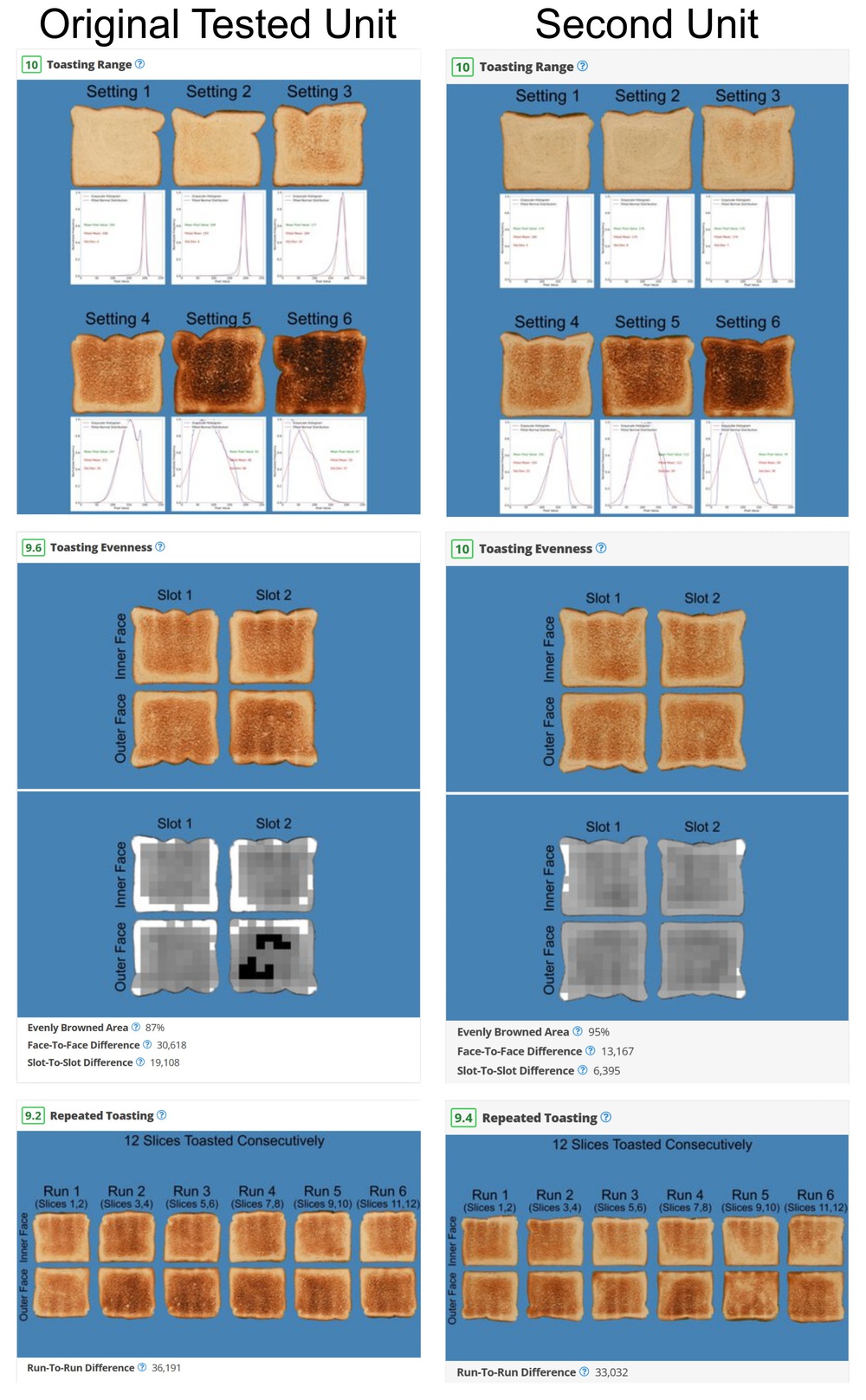
Test results for the Black+Decker 2-slice toaster show that the two units we purchased perform equally well.
In addition to the second Black+Decker unit, we also took the opportunity to purchase a second 4-slot toaster at the high end of the price spectrum to further deduce if the manufacturing quality of toasters is consistent. The Breville Die-Cast 4-Slice Smart Toaster performs decently in our tests; it can produce the full range of toast shades from pale to charred and creates nicely even golden-browned toast. The following figure shows that the second unit we purchased performed similarly to the original. However, some distinct dissimilarities are observed between the Breville units, such as less slot-to-slot difference in the second unit (where slot 1 of the original unit produced slightly darker toast than the other slots). This difference is reflected in the "Toasting Evenness" box score, which increased from 8.2 to 9.5. Where the Breville lacks is its repeated toasting performance, wherein bread comes out darker after a few successive cycles of the appliance. Indeed, the second unit also demonstrates this behavior, with the toast (especially the outer faces) being noticeably darker even after the first run. However, similar to "Toasting Evenness," "Repeated Toasting" performance is better with the second Breville unit (with a score of 6.1 compared to 5.1).
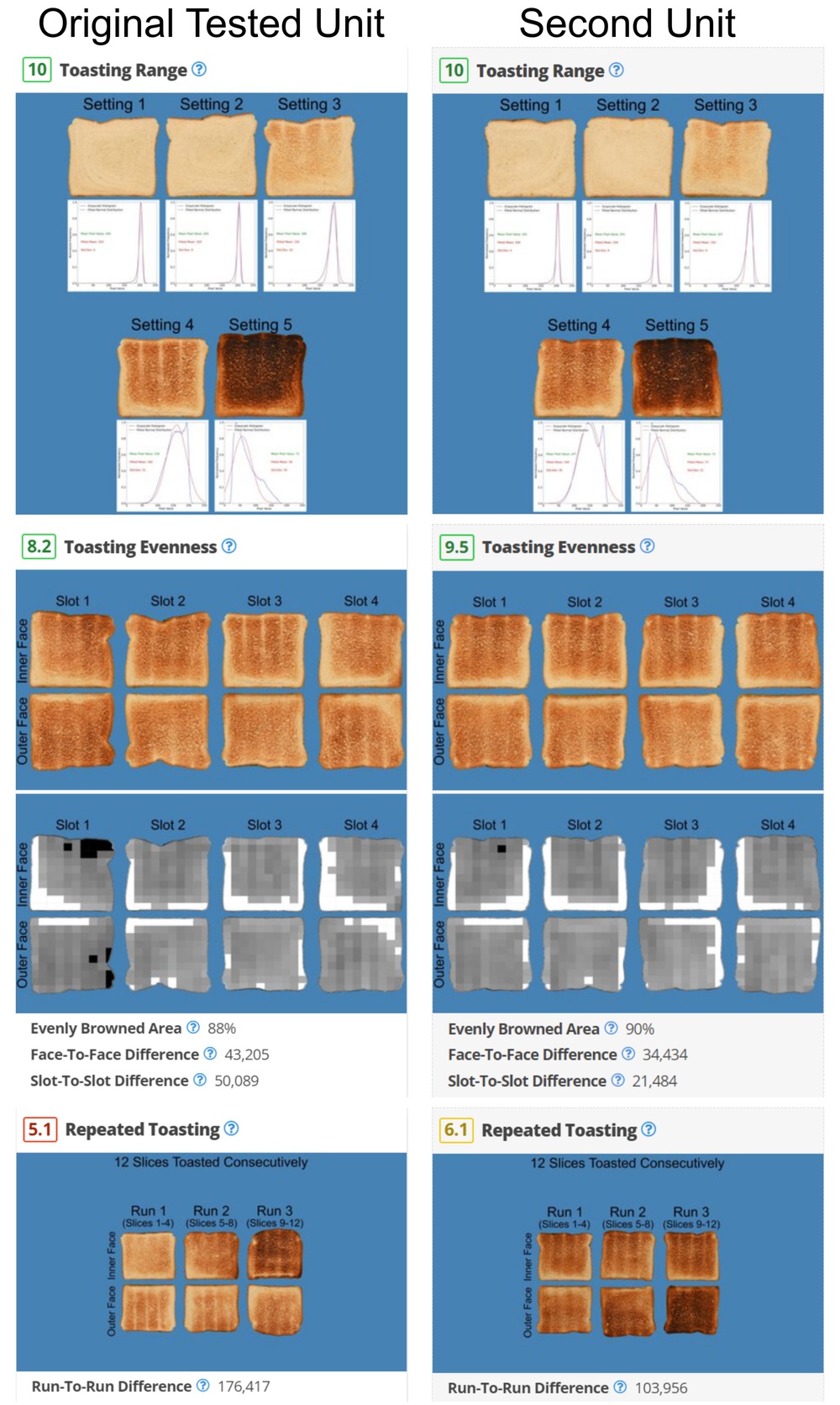
Test results for the Breville Die-Cast Smart toaster show that the two separate units we purchased perform equally well.
The additional testing we undertook with the second Black+Decker unit suggests that you can feel comfortable buying this toaster at the low end of the price spectrum. We observe limited variance in units of the same toaster model (which aren't defective from the factory). However, A second Breville unit did show some variance from the original unit we tested. Unit-to-unit variation is not something we considered in the Toaster test bench but may be a factor for some models.
Conclusion
We have developed a test bench for slot toasters, allowing us to objectively assess this ubiquitous appliance's performance using image processing techniques. The test bench scoring is limited to toasting performance, with our ratings not considering the quality of life features like extra settings, controls, or body material, which may be important for some shoppers. The cohort of 20 toasters we bought and tested consists of a range of price points and includes traditional 2-slot toasters, 2-slot long toasters, and 4-slot toasters. In testing a batch of appliances, we have observed no correlation between price and overall toasting performance. Our highest-rated toaster overall is the $29 Black+Decker 2-slice. We purchased a second unit of this model to confirm that we didn't get a lucky one-off high-performing toaster. By deconstructing the toasters, we have observed a remarkable similarity between the construction of their toasting slots and toasting elements. The difference in performance seems to largely depend on the construction of their bodies and heat transfer to the surrounding environment. Toasters that perform well overall have been shown using infrared imaging to transfer heat evenly from their bodies, avoiding the creation of a large temperature gradient within the slots. We invite you to explore the results and find the best toaster for your needs!
